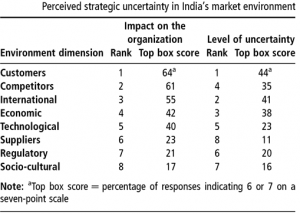In my last post on competitive intelligence, I discussed how competitive intelligence can help improve the bottomline in emerging markets. In our article published in Journal of Business and Industrial Marketing, we observed that Competitive Intelligence (CI) activities have an impact on the market performance of Indian firms. In this post, I want to focus on the following three questions.
-
What are the macro and micro environmental drivers of Competitive Intelligence (CI) for Indian firms?
-
How are CI activities organized within Indian firms?
-
How is the usage and dissemination of CI taking place within Indian firms?
The macro & micro environmental drivers of Competitive Intelligence
Prior research suggests 8 environmental dimensions that have an influence on firm decision making. These include: 1. customers; 2. competitors; 3. international; 4. economic; 5. technological; 6. suppliers; 7. regulatory; and 8. socio-cultural dimensions.
Following the above 8, we asked corporate participants to rank these dimensions on their perceived level of influence on the firm, and their perceived level of strategic uncertainty. For practical reasons, focusing on all these dimensions for decision-making may not be viable for any organization. In this regards, organizations need to prioritize which dimensions to focus on. Focusing on Chinese firms, Tao and Prescott (2000) observed that Chinese companies ranked economic, customer and technological dimensions above others. Other researchers state that while both India and China are growing rapidly on various environmental fronts, the manner of growth for both countries is dramatically different. Our results corroborate this claim.
We find that Indian firms perceive customers and competitors to be having high impact on their organizations. This is not surprising, given the growth of local and international competition in the Indian market in the last one and a half decade. At the same time, these firms are experiencing the maximum level of uncertainty with their customers, international environment, and economic environment . Given that CI can immensely assist managers in reducing environmental uncertainty by understanding the competitive environment as well as customer trends, our findings clearly suggest a critical need for a CI function in Indian firms.
Organization of CI within firms
To fully leverage CI effectiveness, location of CI is highly important. The location of CI within organization decides the budget, types of projects undertaken, and the reporting relationships. In our sample, only three firms have a separate dedicated CI department. However, it is encouraging to see that several firms (37 percent) have integrated their CI activities with their corporate planning process. Though, an overwhelming majority (61 percent) of firms have integrated their CI functions in departments outside corporate planning. Thus, there is concern that in most Indian firms, CI might be used more for tactical as opposed to strategic purposes. This clearly suggests that Indian firms could leverage the full potential of CI activities in a much better manner.
Another interesting observation relates to those firms that have located their CI function in their marketing/market research (23 firms) or sales (14 firms) departments. All these 37 firms had mentioned that customers had the highest impact on their firm. Thirty-four of these firms had also mentioned customers as the source of maximum strategic uncertainty. Also, the majority (65 percent) of the 31 firms that located CI in their IT department expressed technological environment as having a major impact on their firm. Thus, there seems to be a clear relationship between environmental impact and location of CI activities in Indian firms. Regarding CI personnel and budget allocation issues, almost half of our sample firms have five or less people involved in CI activities, and one-third of the firms do not have any specific dedicated personnel. From anecdotal evidence, we found that several CI professionals are also involved in other strategic and marketing functions of the firm, thereby rendering it difficult to assign a specific business function to them. This ambiguity in CI roles is also reflected in the budgetary allocation to CI activities, wherein most companies (65 percent) do not have any specific line item budget for CI activities. The median budget allocated among the remaining firms is approximately $23,000, with only 9 percent of the sample firms budgeting more than $50,000. However, the encouraging news is that approximately 72 percent of these firms are committed to increasing their CI budget in the next three years.
Usage and dissemination of CI
One of the most challenging tasks of a CI professional is to analyze the information, and convert it into intelligence. The quality of analysis is highly important for effective decision-making at the firm level, as the more sophisticated the analytical technique, the better will be the intelligence output. We found that a majority of the firms (73 percent) used less than five techniques on a regular basis. Foreign-owned subsidiaries and international joint ventures were the most sophisticated in using a variety of techniques (on an average more than ten were used on a regular basis). Privately held smaller firms were the next most sophisticated companies in terms of analytical techniques used. The five most common analytical techniques being used by our sample were critical success factor analysis (58 percent), strengths and weaknesses analysis (46 percent), benchmarking (39 percent), Porter’s five forces industry analysis (37 percent), and customer satisfaction surveys (34 percent). This provides us with an indication that there are tremendous prospects for global CI consultants in the Indian market, who can bring in more sophisticated analytical techniques to their potential clients.
In India, approximately 20 percent of the respondents have indicated that their corporate planning department is the primary user of CI, while 14 percent have mentioned that CI is exclusively used by the marketing department. However, in the majority of the firms (58 percent), CI is collectively used by their corporate planning and marketing departments as well as other senior executives. This pattern of CI use in India is very similar to that of USA.
Thus, we asked the respondents to rate 13 methods of dissemination regarding the users’ perceived effectiveness. The five most often used modes of dissemination are memos (81 percent), formal written reports (67 percent), oral briefings (59 percent), regularly scheduled presentations (52 percent), and e-mails (44 percent). A majority of respondents used two or more dissemination methods, which is quite common across the globe.
There are many other interesting nuggets available within the full paper. Use the link given below to read further.
Source: Phani Tej Adidam, Madhumita Banerjee, Paurav Shukla, (2012) “Competitive intelligence and firm’s performance in emerging markets: an exploratory study in India“, Journal of Business & Industrial Marketing, Vol. 27 Issue: 3, pp.242 – 254. (http://dx.doi.org/10.1108/08858621211207252)








